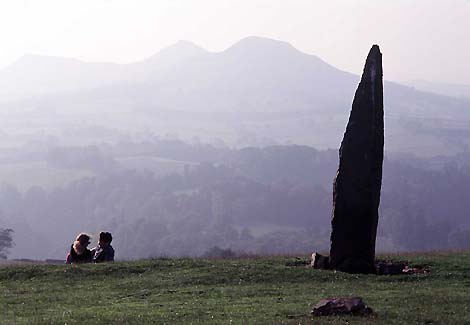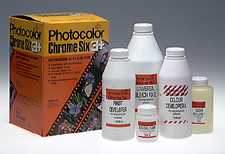

The new generation films - Velvia, Provia, Sensia, Panther, Elite and Agfa RSX - have caused problems with 'straight' E-6 kits, especially three-bath simplified types. Inadequate bleaching is a common difficulty, and poor gradation, casts or density problems have also been seen. Processing mixed film types in small kits has also thrown up visible failures.
The new Chrome Six 3+ kit from Photocolor is intended to overcome all but the last problem, and carries advice not to process different modern E-6 stocks in a small tank together. Its reformulated first developer and extended bleach-fix time in a new one-part blix are accompanied by new timings, push-pull instructions, and a final stabilizer rinse.
The 1200ml kit is the most convenient to keep around for emergencies. It has a shelf life of a couple of years, and will process fifteen films if you are prepared to use progressively longer times. In practice, it is easy to mix up as four 300ml or two 600ml batches and the opened concentrates will keep a few weeks, especially if an anti-oxidant spray is used before re-sealing.
The overall process time including mixing, tank tempering and cleaning up is around one working hour. We tested the kit on two Fuji Sensia 100 films, using 600ml, and mainly used products from the makers of Photocolor, Paterson Photax group.
A couple of washing-up bowls held water at around 43 degrees C for pre-heating the tank (4 minutes) and the chemicals in three 600ml Paterson clear polystyrene measures. These are by far the best around, as they are not only excellent for viewing and mixing, but seem to keep very stable temperatures while also warming up rapidly in tempering baths. A Paterson System 4 dev tank for two films was used, and all the processing and mixing took place in a 20 x 24" Paterson dev dish placed in our S W Brown wetbench, which it just fits.
The darkroom mixer taps were set for 38C rinses and wash, and fitted with a Paterson 20 micron stainless steel fast-flow filter (an Ametek filter was already in the main supply line). The concentrates were mixed a few minutes before use, using boiled water from an electric kettle as well as the 38C filtered tap water. This allowed precise mixing to 38C on the spot. Temperatures were controlled using a Paterson thermometer certified to 1/4C.
The first development would have been 6 minutes 40 seconds with two films in the tank (midway between the 1st and 2nd film timings given) at 38C. Temperature drift monitoring gave a final timing of 7 minutes 40 seconds. Colour development, after a 3 minute rinse, was for 6 minutes.
The blix was given slightly more than the recommended 10 minutes, and the final wash was given 5 rather than 4 minutes. The films were stabilized then squeegeed using Paterson rubber bladed tongs, and hung in an RK drying cabinet on full power.

Eildon Hills, Scottish Borders, photographed using a Minolta CLE with 90mm Summicron-C lens, on Fujichrome Sensia 100 processed in the Chrome Six Plus kit
The results (example above) were exceptionally clean, bright, perfectly processed rolls with strikingly good maximum density and clean whites. Contrast was perhaps a little high, and colours tended towards cool shadows and warmer highlights. The overall colour quality was not precisely the same as lab processed Sensia, but in terms of freedom from dirt and scratches it was probably better. Filmspeed was correctly maintained.
Our conclusion - having deliberately put 'real' films through this test, ones which mattered - was one of relief and satisfaction. The processing was done jointly by Shirley and myself, Shirley mixing and tempering while I processed, and it certainly made life much easier having two people to work for half an hour on it. The immediate temptation was to find another couple of films and use the rest of the kit.
We would probably never keep solutions to squeeze the most out of the �20 ($30) or so which a kit costs, but would only process this way in emergencies. A one-shot cost of �5 per film is not excessive compared to the costs of driving to a lab and paying maybe �3.50 a film for a one-hour service, while you kick your heels; save the petrol, and spend the hour processing the film yourself.
This test used only amateur level equipment, kitchen sink bowls, hot and cold water, common sense, time and temperature. Actual chemical mixing took a few minutes and only one solution, the first dev, needed two concentrates - all the rest were diluted from a single stock. In short, this kit is something which every photographer should keep around, along with a tank, accurate thermometer and measures. There can be more profitable ways to spend an hour, sure, but when you need results fast you can now have the convenience of a quick and easy 3-bath E-6 and get the full benefit your new-generation E-6 slide film.